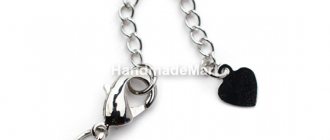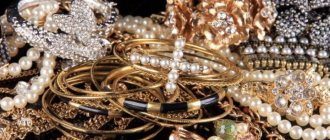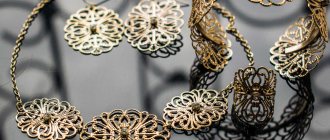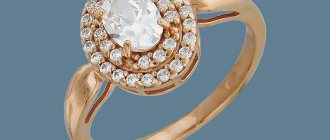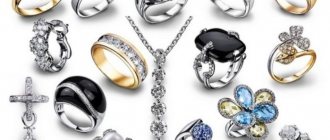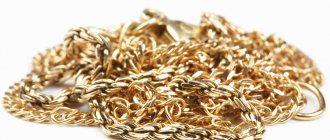- Jewelry alloy - what is it?
- Medical and other stainless steels
- Jewelry alloys without claims
- Alloy and other hint designations in alloys
- Titanium alloys
- Copper alloys
- Coatings of jewelry alloys Rhodium plating How is rhodium plating obtained?
- How durable is rhodium plating?
There are many little things that are useful when creating handmade jewelry. They are chosen based on style, size, fastening features or operation of the built-in tiny mechanism. And now all the external parameters of choice have been taken into account, but questions remain. How will the fittings you like in the product behave? Will the color change? Will it lose its shine? Won't it break? How many of these “li’s” confuse needlewomen, especially beginners, when selecting a clasp, end cap, frame, base. Well, the simplest pin becomes a reason for doubt when purchasing and bitter disappointment at the stage of assembling the jewelry or, even worse, when wearing it. To be less disappointed, let's talk about the variety of materials from which modern metal fittings are made. About their weight, strength, wear resistance and other features.
Jewelry alloy - what is it?
The term “alloy” refers to a homogeneous substance obtained by melting several solid fusible components. For jewelry purposes, metals are used that have an attractive color, shine, malleability, ductility and, most importantly, safety: the absence of reactions harmful to a living organism upon close contact with it. All these characteristics are inherent in noble metals, which is why they are noble. But their high price forces us to look for alternatives. It is precisely to imitate the properties of noble metals necessary in jewelry, but at a lower cost, that all experiments with jewelry and costume jewelry alloys are aimed at.
Copper, nickel, aluminum, iron, tin, titanium, zinc, etc. are suitable for such experiments to one degree or another and subject to certain conditions. Combinations of components, fused together in different proportions, with various additives made it possible to obtain the existing abundance of alloys. Each of them, combining the properties of its components, has its own unique characteristics. In each, the pros compensate for the cons and vice versa. Some alloys have a luxurious shine, but are also fragile. Others are simple in appearance: they quickly fade and oxidize, but are so flexible and malleable that they can withstand repeated bends in the same place without breaking. Still others are so light that they can make even a large element weightless, but where weighting is required they are stupid. Fourth, they withstand the test of the scorching sun, sea water, creams, perfumes and other aggressive chemicals. But for skin prone to allergic reactions, they themselves become a cruel test.
All behavioral features of any alloy, knowing its composition, are not difficult to predict. So, for example, copper tends to become covered with scale during oxidation, which means that an alloy based on it will, at a minimum, darken over time. Aluminum is light, soft and fracture-resistant, which means lightweight fittings made of aluminum alloys should be protected from stress and scratches. The problem is that the composition of its proprietary jewelry alloy is kept secret by any more or less worthwhile manufacturer. And from those who are not worth it, you can expect any surprises at all.
Let us say right away that without laboratory chemical analysis it is impossible to determine the exact composition of the alloy. But upon careful examination, some secrets of the secret composition are revealed:
- The predominance of tin in the alloy gives a dull grayish tint. Tin fittings are quite fragile.
- A dull reddish tint indicates the presence of copper. Discoloration of copper alloy hardware should be expected. For semi-antique products this is an advantage, not a disadvantage.
- Yellow-green shades help to recognize brass alloys (copper and zinc). They look elegant and are polished to a mirror shine. However, an allergy test before use will not hurt.
- Titanium alloys are recognized by their noticeable noble silveriness and respectable price. The price is justified: the combination of lightness with resistance to mechanical and chemical influences is worth a lot.
- Cold shine and noticeable solidity even in appearance are revealed by steel. Perhaps medical - that doesn’t matter. But if dark tones are discernible in the steel sheen, this hints at a high nickel content in the steel alloy. And nickel is also a powerful allergen.
Echoes of man-made disasters
Jewelry taken from a man-made disaster zone is dangerous for the owner because it has absorbed a certain dose of radiation and emits it. Horrible disasters often happen in the world, the consequences of which become fatal for humanity. At the top of the ominous list are accidents at nuclear reactors at power plants. As a rule, they are accompanied by a large number of deaths and considerable economic losses. And few people think about what other terrible consequences of these accidents can occur even after many years for people who have absolutely nothing to do with them.
The fact is that when a person hastily leaves his home due to an urgent evacuation, he takes with him all the most valuable things. As a rule, none of the same Chernobyl victims destroyed gold and jewelry, as required by the instructions. On the contrary, these simple values helped them survive and get back on their feet where they found themselves after escaping from danger. Therefore, a huge amount of radioactive gold spread throughout the country.
Some of it was melted down, some was left in memory of my grandmother or mother, some jewelry was simply old, and therefore especially valuable. Today, the “Chernobyl treasures” are digging a grave for their victims, along with the radiation that fell on innocent people from the exploded mouth of the reactor.
Medical and other stainless steels
Familiar from an early age with the shine of spoons, forks and other cutlery, “stainless steel” is the absolute leader among jewelry alloys used in the manufacture of modern accessories. Let's start with it.
Already by the spoon, which has served unbendingly for decades, one can judge the quality and service life of steel accessories for ladies’ jewelry. The spoon looks like new, despite repeated immersions in aggressive chemical environments. And it’s okay if it’s just soup, her shiny one doesn’t even care about the effervescent reactions of soda and vinegar. Even if you hit the table with all your might, it will survive, unless it leaves a scratch or a dent, but it won’t hurt the tabletop either. And how elegant stainless steel spoons can be, here you will find curls, embossing, and gilding. And all this at a reasonable price: it is incomparable with the price of the same silverware.
Stainless steel is in demand in costume jewelry for the same reasons. The resilient material is relatively inexpensive and, importantly, harmless to health, even in cases of close and prolonged contact with bare skin. By the way, it is safety that many manufacturers and sellers of steel fittings claim as one of the most important advantages. They even write “medical steel” on the product cards or product passport. And this is where logical questions arise. If the earring wire is indeed made of the same alloy that is used on surgical instruments, can it be threaded into a newly pierced earlobe? Won't a small wound require a lot of treatment after this? Will the wire itself deteriorate, oxidizing and darkening? Yes, yes, this happens sometimes. Stainless steel, the same one that is harmless and outwardly unchanged, turns out to be capable of breaking its own rules. However, it only inevitably becomes a consequence of breaking the rules, for the sake of improving aesthetics or reducing production costs.
Stainless steel is an alloy of steel (iron and carbon) and chromium. The chromium content usually does not exceed 11-18%. This is enough for the so-called “alloying” - adding impurities and additives that improve the quality of the base material.
The fact is that iron is highly susceptible to oxidation. Under the influence of oxygen contained in water or air, it is destroyed and becomes corroded. Chromium, which is present in stainless steel, also reacts with oxygen and is also covered with a layer of oxides. And the trick is that the film of chromium oxide is invisible to the eye, but by covering the steel surface impenetrably, it prevents contact of iron with oxidizing agents, thereby protecting it from corrosion.
There are many grades of stainless steel used in various sectors of the economy and industry. All of them, due to different impurities and their percentages, differ in the characteristics of weight, strength, malleability, etc.
The same alloys that are used for medical purposes are suitable for jewelry needs: stainless steel marked AISI 304, its improved version AISI 316, etc. However, “medical alloy” and “jewelry alloy” are not always synonymous concepts. Manufacturers often experiment with their own recipes for stainless alloys for fittings, adding, for example, nickel, titanium, molybdenum and other alloying components, which give the finished products additional strength, flexibility, and decorativeness.
For example, nickel serves as an excellent hardener and at the same time enhances shine. Products made from this alloy have an expensive shine. But about a fifth of the world's population suffers from allergic reactions to nickel. A severe case from the ring or earrings is unlikely, but an itchy rash is very likely.
Therefore, it is still not worth relying on the fact that all stainless steel of jewelry alloys is equally “medical”.
It is not uncommon for steel jewelry fittings to have non-standard colors. The silveriness of stainless steel sometimes has a tint, or even a pronounced color. The reason for this may be both coloring impurities in the alloy composition and PVD coating (Physical Vapour Deposition). The first case may contain surprises uncharacteristic of stainless steel, such as a change in color over time from attractive to nondescript. The second is a fairly expensive jewelry technology, which, in addition to a beautiful color, gives the steel additional protection from external influences and significantly increases the price of the finished product.
Summarizing the above, we add that stainless steel fittings are truly irreplaceable. She is appreciated for:
- Strength;
- Wear resistance;
- Resistance to deformation (a ring made of high-quality stainless steel cannot be stretched or compressed, and even the thin backing of a crystal or brooch will not bend at the slightest effort);
- Consistency of color and shine
- Affordable price.
Branded fittings produced by famous brands meet all expectations, although their cost is somewhat higher. But the one that is cheaper, without great fame and a proven reputation, reserves an allowance for the characteristics of semi-handicraft stainless steel. It may turn out to be too fragile, or suddenly darken. If you come across an unfamiliar manufacturer, and the seller cannot provide certificates, then it makes sense to test an element of dubious fittings purchased as a sample, and only then make further plans for it.
Cleaning methods
- A simple soap solution will help remove dirt and skin particles from the product and return it to its former shine. This solution can be used to clean jewelry that has inserts. Thanks to the neutral PH of soap and water, they will not be damaged.
- Sea salt. Helps remove deeper stains. Dissolved in water, it helps remove dirt even from small scratches and hard-to-reach places. In addition, such a solution will help remove even traces of oxidation.
After any composition, jewelry must be wiped dry with a soft cloth.
- Hydrogen peroxide mixed with liquid detergent. Prepare the composition as follows: add 1 teaspoon to 250 ml of water. dishwashing detergent and the same amount of ammonia, as well as 40 ml. peroxide. The water should have a temperature of 38 degrees.
Jewelry alloys without claims
One can only guess about the composition of such an alloy. For example, by color. Thus, inexpensive accessories “gold,” that is, golden, albeit very tinsel, color, are often made from copper, zinc and brass fused together. Depending on the predominance of one of the components, its tone varies from cold yellowish to red gold.
By the way, the presence of copper gives the alloys not only a shade, but also the high ductility characteristic of the metal. A strong and persistent shine may indicate the presence of antimony in the alloy. But aluminum gives off excessive softness, dullness and lightness.
Yes, yes, strength, or rather its absence, is also sometimes determined by the very first tactile contact with a penny trinket. Simple things that do not have a manufacturer's mark or even a hint of any serious production can easily be crushed by slightly squeezing in your fingers, torn or broken without much effort. These signs are given by low-grade silumin - an aluminum alloy with the addition of silicon for strength.
Depending on the quantity and quality of additives, silumin can be quite reliable, as evidenced by its use in plumbing and the production of inexpensive, but high-quality and safe tableware. According to the international system, silumin has the generally accepted ISO marking; its presence already indicates that the alloy meets accepted standards of strength and reliability. There are other identifying symbols. So, if there is an abbreviation AK-15, AL-9, etc., then it contains the initial letters of the names of the alloy components (aluminum-silicon, aluminum-lithium) and their percentage: the additional component in the first case is 15, and in the second 9%.
Indecently cheap jewelry and accessories use silumin, whose manufacturers did not bother much with GOSTs and other standards. That is why the alloy is often porous and fragile. Products made from it quickly become covered with a sloppy coating, and if they break, they cannot be repaired. In particular, such an alloy cannot be soldered at all. No jeweler will definitely undertake such repairs. What's the point? For the cost of repairs you can buy a dozen brand new trinkets.
However, products made of silumin, even of the lowest quality, firmly occupy their niche in the accessories market. Their low cost makes them an excellent educational material, suitable accessories for one-day products, for example, those that are matched to a carnival costume and there are no further plans to wear them.
By the way, silumin fittings can be very durable and also look decent. But here’s the trick: on such fittings, the manufacturer, knowing about the frivolous reputation of silumin for jewelry, tries to write the general neutral “alloy” instead of the honest, specific “silumin”.
100% guarantee: peace of mind at our expense
As you already know, 2-3 of our jewelry per thousand sold become dark. It is not at all difficult for us to meet halfway with the Client and simply return the payment. The client calms down, but for us the losses are ridiculous. It is more important that the Client remains satisfied.
If the jewelry was of poor quality, we would only return the money. And since I am confident in the quality of the products, I can easily afford this approach.
Therefore, we also provide a guarantee for our wholesale Clients: if your retail Client complains about defects or oxidation, we will return your payment. And you can be a generous and decent seller at the expense of the supplier!
Alloy and other hint designations in alloys
The above-mentioned concept Alloy is translated from English as “alloy”. It is thanks to this word that inexpensive jewelry and accessories for it are called “alla” in specialized slang.
By the way, there is a less common and also foreign-language synonym.
- Szpeat (Polish) - means just “mixture”, but is more used as a colloquial one: in Russian it sounds like “shpiatr” or “shpiat”. In general, the word came from the vocabulary of jewelers of the 19th century: this was the name given mainly to zinc alloys, which had become cheap analogues of bronze, and used in artistic crafts.
Knowledge of the designations most often found in product cards and product passports helps to get an idea of strength, flexibility, color stability and other “alloy” qualities:
- Metal Alloy is a fairly general concept; this is how metal jewelry alloys are labeled. They contain anything: copper, aluminum, antimony, tin, etc.
- Zink (Metal) Alloy – but this is a more specific designation. In addition to the generalized “metal alloy,” it also indicates the main component, in this case Zink – zinc. By analogy, other possible alloy bases are indicated:
— Gold – gold (in costume jewelry alloys the predominance of such a noble metal is unlikely, but a hint that it is present in the coating is very possible).
- Silver - silver. But its content, although small, is not uncommon in jewelry alloy.
- Titanium - titanium.
— Copper is copper, it is precisely what is included in the composition of, if not every, then most jewelry alloys.
- Nickel - nickel, also a popular component, although not always desirable, and in a number of countries it is completely prohibited. Therefore, its absence is mentioned more often than its presence:
— Nickel free – the mark means “without nickel.”
- Lead free - and this one is “lead free”, which has also long been recognized as harmful to health.
— Iron – iron, rarely mentioned, more often it is represented by steel.
- surgical steel - surgical steel, which is worth focusing on: the same one that is used in medical earrings for ear piercing, and with a guarantee of complete absence of allergic reactions
- Brass - this is how copper alloys with zinc or brass are usually marked.
- Plated – and this mark can appear on an alloy of any composition, but it is not superfluous to remember it. It indicates a durable coating, which, firstly, protects the product itself, and secondly, neutralizes the possible harmful effects of alloy components.
Darkening is a statistical error
For us, Customer satisfaction is issue No. 1. Therefore, we have objective detailed statistics of all problem situations, including defects and darkening of jewelry.
This is what the statistics on the satisfaction of our RETAIL Clients looks like for a short period in early spring.
It is very important to consider retail sales - retail customers immediately begin to use jewelry , so the statistics are more objective. For wholesale Clients, jewelry may linger for a significant period of time in a warehouse or counter. And products darken, as a rule, precisely when worn.
Titanium alloys
Let's start with the fact that it is impossible to find titanium accessories for jewelry in displays of inexpensive goods. Titanium is not a noble metal and is not tested. But titanium jewelry is expensive and cannot be anything else. Metal is very difficult to process. Not every experienced jeweler takes it on even now. And until the 90s of the last century, it was not used at all for beauty needs, more and more in complex technology, spaceships inclusive.
But the hassle of processing titanium is justified. The watchmakers were the first to bother and received amazingly light, durable and beautiful cases. Jewelers adopted the experience. And only then products made from titanium alloys began to gradually appear on the accessories market, becoming more and more popular.
Despite its low specific gravity, the metal is distinguished by its high strength: it is almost half lighter and three times stronger than steel. Titanium products are called eternal. No dents, scratches, darkening or clouding during daily wear in any conditions. Metal does not cause allergic reactions. Cases of allergies to gold and silver, although rare, are recorded, but not to titanium. Titanium itself, which has a cold silver tone, when oxidized, is painted in a rich palette of shining metallic colors. Even a small percentage of titanium in a jewelry alloy significantly improves it, endowing it with all the valuable titanium qualities to one degree or another.
There are only three disadvantages to products made from titanium alloys. The first is high cost. If the fittings are inexpensive, rest assured, there is no titanium there. The second is a great rarity: titanium is just beginning to conquer the jewelry market. The third is a lot of fakes. The good reputation of titanium is getting louder, and unscrupulous businessmen are trying to slip anything they want under this bench. So, if you decide to spend a decent amount on purchasing titanium-containing fittings, do it where they will provide you with certificates.
A rare but nasty situation...
Darkening of our jewelry is extremely rare. The evidence will be below. But the question is worth looking into.
Beginner sellers do not have sufficient understanding of this issue. And when a problem occurs, it is difficult to find the right words and make the right decision when communicating with the Client.
Below I will talk about the quality of our products, the stages of control, and about 998 out of 1000 satisfied Clients. This will give you complete insight and peace of mind in the event of one-off jewelry issues with your retail customers.
Copper alloys
It was not without reason that copper became the first metal to be conquered by man. Beautiful, plastic, resistant to corrosion, easy to process and, in view of the still decent global reserves, not expensive either. In modern jewelry, copper in its pure form is practically never found. The metal is very soft and its properties are best revealed in alloys where zinc, nickel and other components are used as alloys.
The reddish tint and the ability to become covered with a noble patina are the first distinguishing features of any copper alloy. But in terms of other properties, copper alloys (of which the absolute majority are among costume jewelry) vary greatly. Let's look at the most popular ones that are used for making jewelry and accessories for it.
- Bronze in the classic version is a high-strength alloy of copper and zinc, but the classic version is not suitable for jewelry needs. The most in demand is the so-called “aluminum bronze”; from the name it is already clear that the main alloy is aluminum, which also makes the product lighter.
One of the advantages of this alloy is its warm golden-yellow hue. A brand new product can really shine, although not mirror-like, but quite bright. However, don't expect the factory shine to last forever. As with all copper alloys, oxidation and, as a result, darkening is inevitable. One of the significant disadvantages of aluminum bronze is its tendency to scratch.
- Cupronickel is a multicomponent alloy, where copper (70-80%) is diluted with nickel (20-30%), the main composition is supplemented by the addition of iron, manganese, and often silver.
The durable, hard, heavy alloy is distinguished by its external nobility: it looks like silver. By the way, cupronickel is our word, but outside the former USSR, alloys of similar composition are called “German silver”. Why German? But because “silver” coins from cupronickel were minted in Germany. But we love the alloy everywhere because it allows us to get jewelry that looks more expensive than its value. That is why Europeans have another name for it: “silver for the poor.” One of the disadvantages of the alloy is an unsightly dark coating, with which it instantly becomes overgrown. But this coating is easy to clean. So, in addition to cupronickel, they immediately buy products to care for it. At home, use a pharmaceutical solution of ammonia. With proper care, products last a long time.
- Nickel silver - the name translates as “new silver”; in fact, it is also an alloy of copper with zinc and nickel. In appearance it resembles nickel silver and is often confused with it.
However, there is a little more yellow in the nickel silver shade (deviations into blue and green are possible). Compared to cupronickel, the alloy is less durable and much cheaper, which is due to a significant difference in the proportions of the components: there is less copper in it, only about 40%, about 45% is zinc and about 15% is nickel. Hence the high probability of allergic reactions. Products made from nickel silver should be protected from moisture. It is better to store in a closed box, which slows down the process of oxidation and darkening. You can clean it by dipping it in a solution of soda, potash or gasoline. The alloy is often used as a basis for durable coatings, including silvering and gilding - with such products there is less hassle.
- Alpacas - in this case, it’s not about woolly calloused animals, but about an improved Mexican version of the previous silver-like alloy. In jewelry from those places, you can even see the production mark “Alpaca” or “Alpaca”: both options are correct, apparently they just didn’t agree on common spelling rules.
Alpaca contains about 60% copper, 20% nickel, 20% zinc. And the 5% addition of tin gives the alloy a grayish tint, additional lightness and ductility. It also darkens, and also quickly, but the patina looks aesthetically pleasing.
- Brass - and this alloy of copper and zinc imitates not silver, but gold. What does the English name of the alloy “yellow brass” mean – yellow copper. The alloy resembles gold not only because of its warm glow. The properties of brass grades L68 or L62 are so close to those exhibited by 583 gold that the alloy becomes a suitable training material for training jewelers.
Due to the long service life of the durable, corrosion-resistant alloy, it is called the “eternal metal”. Unlike bronze, brass is softer, which makes it easier to process, and more resistant to aggressive influences, such as salty sea water. And compared to steel, brass is heavier.
Brands of brass, in fact, differ in the content of zinc (from 5 to 45%) and additional additives; very harmful additives are possible, such as bismuth and arsenic, so brass fittings from an unverified manufacturer are fraught with unpleasant surprises.
The amount of zinc varies the properties of brass: the more it is, the stronger the alloy, without loss of ductility. But, at the same time, if the amount of zinc exceeds 20%, then rumors about the “eternity of the metal” become greatly exaggerated: such an alloy is susceptible to corrosion cracks, especially in high humidity and contact with ammonia fumes.
The amount of zinc in an alloy can be determined by the color of brass: if zinc is less than 20%, the color of the alloy is bright golden, orange-reddish, muted yellow shades indicate that there is 20-36% zinc, and a greenish tint indicates a high zinc content - from 36% and more.
Thanks to the abundance of brands, brass serves as a universal alloy used in various fields. Brass is used to make musical instruments and plumbing parts; it is successfully used in electronics and interior design. What is also appreciated in costume jewelry is that brass allows the casting of complex, detailed shapes. Such fittings are beautiful and durable even without galvanic coating. It is covered with a noble layer of greenish patina and looks like a museum rarity. With regular cleaning, patina can be easily avoided. There are special pastes for cleaning brass. At home, use a mixture of flour and salt in equal proportions, brought to a mushy consistency with a table solution of acetic acid.
Gold-plated brass is similar in appearance to noble metal. True, in terms of weight, although it is quite heavy, it is still inferior to gold, just as it is inferior in price. In general, it is not difficult to distinguish brass from gold. Brass is often attracted by a magnet, leaving behind a gray rather than yellow line on the ceramic surface, its color is less saturated, its shine is less pronounced. But, by the way, brass holds up coatings better than other alloys, so that under a layer of gilding, an amateur will distinguish it from gold only by the lack of hallmark. Brass also reliably holds galvanic coatings: chrome plating, nickel plating and the so-called “antique bronze”.
- Tombak (or tombak from the French Tombac). It has been used for a long time, therefore it has other names: similor, oreid, chrysochalk, chryzoin, princetal. In fact, this is one of the most decorative varieties of brass, which contains no more than 10% zinc. Alloys with a higher zinc content (up to 30%) are classified as semi-solid alloys.
- Tin alloys – silver-colored tin is lightweight, corrosion-resistant and non-toxic. However, the metal itself is brittle and refractory, which requires ligation with components that compensate for this deficiency. Among tin alloys, so-called pewters are used in jewelry making.
Pewters (alloys of tin with antimony, bismuth, copper, and sometimes lead) are characterized by aesthetics and ease of polishing. Copper gives such alloys ductility, aluminum gives strength, and antimony adds brightness. In terms of external qualities, slightly matte products reminiscent of platinum and white gold are magnificent; it is from them that convincing replicas of famous jewelry are often made. But due to harmful impurities, pewter in a number of countries is also an alloy prohibited in costume jewelry. Another disadvantage of pewters is their tendency to the so-called “tin plague”. Low temperatures provoke gray spots on the surface of pewter alloys and subsequent destruction, even crumbling into powder. In severe (below -30 degrees) frost this happens quickly. Chemical surface treatment or coating with decorative enamel mitigates the problem, but products made from tin alloys still require careful handling.
- Tibetan silver is one of the currently popular hoaxes that has nothing to do with historical Tibetan silver, and indeed with silver in general. Although the current costume jewelry and accessories are really similar to the jewelry created in ancient times in Tibet. In fact, this supposedly expensive alloy contains the same copper, brass and zinc. Depending on the proportions, the color of the alloy varies from yellow to reddish.
- Unnamed nickel-containing alloys - in many countries, jewelry alloys containing nickel are officially prohibited. But in our market the lion's share of inexpensive fittings is made from them.
The composition of such alloys is unpredictable; everything from iron to aluminum can be found in it. Fragility and darkening are a distinctive feature of such fittings, but their low cost makes them still in demand. In order to give the dubious alloy at least some tempting value, enterprising businessmen sometimes resoundingly call them “Monel”.
Monel is indeed a nickel-containing alloy and is quite respected. But accessories for jewelry are not made from it. Due to the high content of nickel, as well as iron, manganese and other additives that strengthen it, the alloy is difficult to process. It is used to make durable zippers, rivets and other reinforced fittings for outerwear, bags, etc. Jewelry needs do not require such strength.
How to protect your jewelry?
To prevent jewelry from darkening or oxidizing, it should be worn and stored properly. Nowadays, popular trees and jewelry hangers are suitable only for temporary storage of jewelry. Dust settles on it, sunlight and other undesirable factors affect it.
Ideally, you should store your jewelry in a closed box, pencil case, organizer or cabinet, flattened. It is advisable to assign each piece of jewelry a separate compartment, and perfectionists store jewelry in personal bags and boxes. It’s good to put sachets of silica gel in the box, which removes moisture.
Silver pendant with amber (go to the SUNLIGHT catalogue)
It is virtually impossible to prevent jewelry from darkening at all, especially if it is made of “bare” alloys without coating. However, you can pause this process.
- Keep jewelry away from sources of heat and moisture, and protect from direct sunlight.
- Be sure to remove jewelry at night, during water procedures, physical labor and training.
- Apply creams and perfume first, and only then put on jewelry.
Take the time to coat the jewelry so that it does not oxidize so intensely. There are special varnishes for this, and some can cover not only metal (including fittings), but also stone, wood, glass, and so on.
The layer of varnish on the jewelry wears off over time. But it doesn’t matter: one bottle of good varnish will last you a very long time.
Jewelry alloy coatings
Like jewelry alloys, costume jewelry is combined with coating. Depending on the composition and method of application, the coating strengthens, protects, and decorates the product. Moreover, some types of coatings can successfully perform all these functions at the same time.
Rhodium plating
The most spectacular and expensive coating, which is not surprising. After all, the metal used is the platinum group, which is also the rarest of all those mined from the bowels of the Earth. The rhodium layer is even applied to products made of precious metals, without in any way detracting from their value. It protects gold items from scratches, silver items from darkening, and in items with precious stones it enhances shine, which affects the refraction of light. In the case of rhodium-plated fittings, everything is the same, but in an economical version. However, economy is only in comparison with jewelry, but among costume jewelry, rhodium-plated products are one of the most expensive.
Rhodium is the 45th element from the periodic table. It got its name from the Greek ροδον - rose. The fact is that in a native platinum solution it is a bright pink powdery sediment. It turns into a silver-white, very shiny, does not fade over time, and is a very heavy metal after rolling under the influence of hydrogen.
The metal itself is unsuitable for fine jewelry due to its high hardness, combined with high fragility. Not every left-hander can cope with such intractability, giving rhodium a shape, much less an elegant one. After all, the metal acquires plasticity, even relative, only when heated, and its melting point is 1,960 °C (for comparison, for gold this figure is 1064.18 °C).
Rhodium is a chemically inert metal, that is, it does not enter into any reactions, which means it is not capable of oxidizing, darkening or completely collapsing under the influence of aggressive chemistry. Nor is it capable of causing allergies. Gold, by the way, contrary to idle speculation, is also chemically inert and cannot be an allergen. If a gold bracelet or chain causes a rash, swelling and other troubles, then the problem is not in the gold, but in its low standard. A sample is nothing more than an indication of how much gold is contained in a gram of a gold-containing alloy. The highest standard for jewelry, 985, indicates that 1 gram of alloy contains 985 mg of gold. But the so-called “white gold” is fairly diluted with silver, and even allergy-provoking nickel. Rhodium coating of “white gold” and other allergic active alloys blocks the action of the allergen.
All of the listed properties of rhodium serve to improve the appearance of products, increase their strength, wear and heat resistance.
How is rhodium plating obtained?
A thin rhodium layer (0.1 - 0.25 microns) is applied to the finished product by galvanic method. The defatted product is placed in a galvanic bath filled with an aqueous solution of rhodium salts and exposed to an electric discharge. During the electrochemical reaction, rhodium melts and envelops the alloy. Moreover, depending on the composition of rhodium salts, the coating can take on not only white metallic shades, but a more powerful electrical effect makes it darker, even black. To increase the thickness of the decorative protective layer, the procedure is repeated several times. The thicker the layer, the higher its protective and decorative properties, and, accordingly, the more expensive the product.
conclusions
Under certain conditions, any jewelry darkens: jewelry and costume jewelry, expensive and cheap.
Costume jewelry “Sea of Shine” is high-quality and durable, it can be safely sold at retail. This is confirmed by statistics and crash tests.
We guarantee that in the event of a Customer complaint, you will receive full compensation for the wholesale price of the jewelry simply based on a photo of the defect or darkening
It is important to provide clients with care recommendations
In most cases of darkening, the jewelry can be cleaned with a special product or cloth.
Story
According to data that have reached the present day, even in the Stone Age, before the advent of clothing, girls decorated their bodies with a thread with an unusual stone. They also supplemented them with shells, flowers and feathers.
In some countries, alloys and stones were equated to money. Thus, in Egypt, the “aggri” bead was used as monetary currency.
In the 18th century, variations of rubies and diamonds began to be produced, which were called rhinestones. The stones received this name in honor of Georges Strass.
In the 19th century, rhinestones began to complement products. Daniel Swarovski invented a machine that created stones from rock crystal. In honor of him, the stones were named Swarovski. In appearance, they were not inferior to more expensive stones and were distinguished by amazing brilliance.
For the first time, costume jewelry became widely available in the 19th and 20th centuries. Such products were created to order and were very popular. Wearing jewelry was stylish. This meant that the girl had her own taste.
The word jewelry comes from the French. “bijouterie”, which means “inexpensive metal”.
Previously, even fabric, ceramics and plastic were used for manufacturing.
Not everyone could afford to buy expensive jewelry, so Coco Chanel costume jewelry was created. Its main differences were in bright colors and large dimensions.
Where is costume jewelry made?
There are several main countries that can boast of the quality of their products. They prove that costume jewelry can look much better than gold jewelry.
- Italy is a leader in the production of costume jewelry. The jewelry that is made there is very popular all over the world. Murano glass is produced on the island of Murano, which is distinguished by its unusual appearance. The jewelry is handmade by the best Italian jewelers. This type of jewelry is not budget friendly.
- France. There are several companies in this country that specialize specifically in the production of costume jewelry.
- The Czech Republic is famous for its pomegranate products. Jewelers use the alloy “tompak”, which does not cause allergies in humans.
- Belgium is distinguished by good quality jewelry. They serve their owner for a long time and do not darken.
To avoid deformation, all jewelry should be removed during intense activity, such as running or fitness. To extend the life of jewelry, it is better to wear it only when going out and take it off when performing household chores.
Properly selected jewelry can highlight the beauty and complement any look. Nowadays, massive jewelry made from alloy jewelry is in fashion - these are weighty bracelets and pendants in a geometric design. It’s also worth taking a closer look at the new trend – brooches. They are distinguished by their varied appearance and shape.
Characteristics
The main advantages of jewelry alloy
- Price. It's no secret that jewelry made from alloy jewelry will cost much less. Fashion is constantly changing, and there is no point in buying expensive jewelry every season. For designers, this is a salvation, because the choice of products is very wide.
- Wide availability. You can buy jewelry in any store, and their selection is impressive. Any fashionista will find something to her liking.
- Almost everyone can wear jewelry.
The main disadvantages of jewelry alloy
- Fragility. Not all materials can boast a long service life. Constant bending may cause the decoration to break.
- When exposed to an aggressive environment, they quickly lose their appearance. Many girls forget to take off their rings and earrings when swimming in ponds, otherwise they quickly become unusable. From constant contact with water and soap, jewelry loses its shine. Acid, alcohol and detergents negatively affect the color of the metal.
- The composition of the product is not always indicated. This way manufacturers can sell cheap material at a high price.


